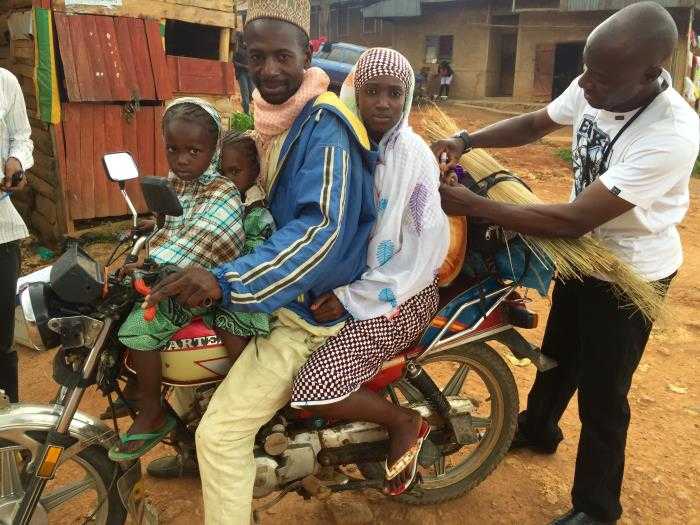Polio

Nigerian family on a motorcycle receiving the polio vaccine. By Lisa K. Esapa. View this image or search images by topic on the Public Health Image Library (PHIL)
Polio, or poliomyelitis, is a crippling and potentially deadly infectious disease caused by a virus that spreads from person to person invading the brain and spinal cord which can lead to paralysis. 1 in 200 infections leads to irreversible paralysis. Of those paralyzed, 5% to 10% die when their breathing muscles become immobilized. Additionally, even children who seem to fully recover can develop new muscle pain, weakness, or paralysis as adults, 15 to 40 years later. This is called post-polio syndrome.
There is no cure, but there are safe and effective vaccines to prevent polio infection. Polio vaccine protects children by preparing their bodies to fight the polio virus. Almost all children (99%) who get all the recommended doses of vaccine will be protected from polio. Therefore, the strategy to eradicate polio is based on prevention by immunizing every child to stop transmission and ultimately make the world polio-free.
What is the global impact of polio?
- Four regions of the world are certified polio free—the Americas, Europe, South East Asia and the Western Pacific.
- Three polio-endemic countries (countries that have never interrupted the transmission of wild poliovirus) remain—Afghanistan, Nigeria, and Pakistan. In 2016, only 37 cases of polio were found in those last pockets, the smallest number of new cases in history.
- Not so long ago – 1988, in fact – polio circulated in more than 125 countries, where it paralyzed 350,000 children each year.
- If a population is seriously under-immunized, vaccine-derived poliovirus can begin to circulate in a community. Circulating vaccine-derived polioviruses (cVDPVs) are extremely rare forms of poliovirus, which has circulated for a prolonged period of time uninterrupted and can mutate over the course of 12-18 months.
Who is at risk?
- When you look at where wild polio cases or vaccine-derived poliovirus cases are arising today, they are all in places of unrest and with varying complex scenarios or limited access – Somalia, DRC, Lake Chad region, Syria, Pakistan, and Afghanistan.
- Most people who get infected with poliovirus (about 72 out of 100) will not have any visible symptoms. Poliovirus is highly contagious, and people who don’t have symptoms can still pass the virus to others and make them sick.
- About 1 in 4 people infected with poliovirus will experience flu-like symptoms, such as sore throat, fever, tiredness, nausea, headache, and stomach pain.
- A smaller proportion of people with poliovirus infection will develop other more serious symptoms that affect the brain and spinal cord, such as paresthesia (feeling “pins and needles” in the legs), meningitis, and paralysis.
- Polio anywhere is a risk to people everywhere. All countries will be at risk of polio importation until it is eradicated globally by preventing infection through vaccination.
What is CDC doing?
- CDC and its international partners have made significant progress over the past 26 years. Through the Global Polio Eradication Initiative, CDC:
- Works jointly with WHO and national Ministries of Health to plan and monitor polio’s spread and immunization activities in multiple countries worldwide
- Evaluates risk and conducts assessments with GPEI partners for the Independent Monitoring Board, which meets quarterly to review performance of at-risk countries towards achieving polio eradication milestones
- Promotes innovation and conducts research to improve immunization against polio and means to detect polio cases
- Supports all 145 member labs in the Global Polio Laboratory Network with critical diagnostic services and genomic sequencing of polioviruses to help guide disease control efforts in many countries
- Performs applied research for supplemental immunization activities
- Deploys personnel and resources to support country eradication efforts
- Trains and deploys international consultants to WHO and UNICEF through the Stop Transmission of Polio (STOP) Program
CDC is working to help stop this crippling disease forever and ensure the lessons learned and polio infrastructure continue to pay dividends to keep Americans safe and save lives around the world. For example, polio infrastructure supports health priorities beyond polio, including in these recent emergency response efforts: Ebola, cholera, measles, Marburg virus and Yellow Fever.
Additional Resources
- Download the Polio & CDC’s Role in the Global Polio Eradication Initiative fact sheet
- Read CDC’s latest polio news releases
- Browse Global Polio images on the CGH Flickr stream or search by topic or country
- Search images by topic on the Public Health Image Library (PHIL)
- Learn more about polio and other vaccine preventable diseases
Contact Media Relations
Contact media relations to speak with a CDC polio expert
-
9:00 a.m. – 6:00 p.m.
(404) 639-3286
media@cdc.gov
-
After Hours
(770) 488-7100
Media Request Form
- Page last reviewed: September 18, 2017
- Page last updated: September 18, 2017
- Content source:
Global Health
Notice: Linking to a non-federal site does not constitute an endorsement by HHS, CDC or any of its employees of the sponsors or the information and products presented on the site.


 ShareCompartir
ShareCompartir